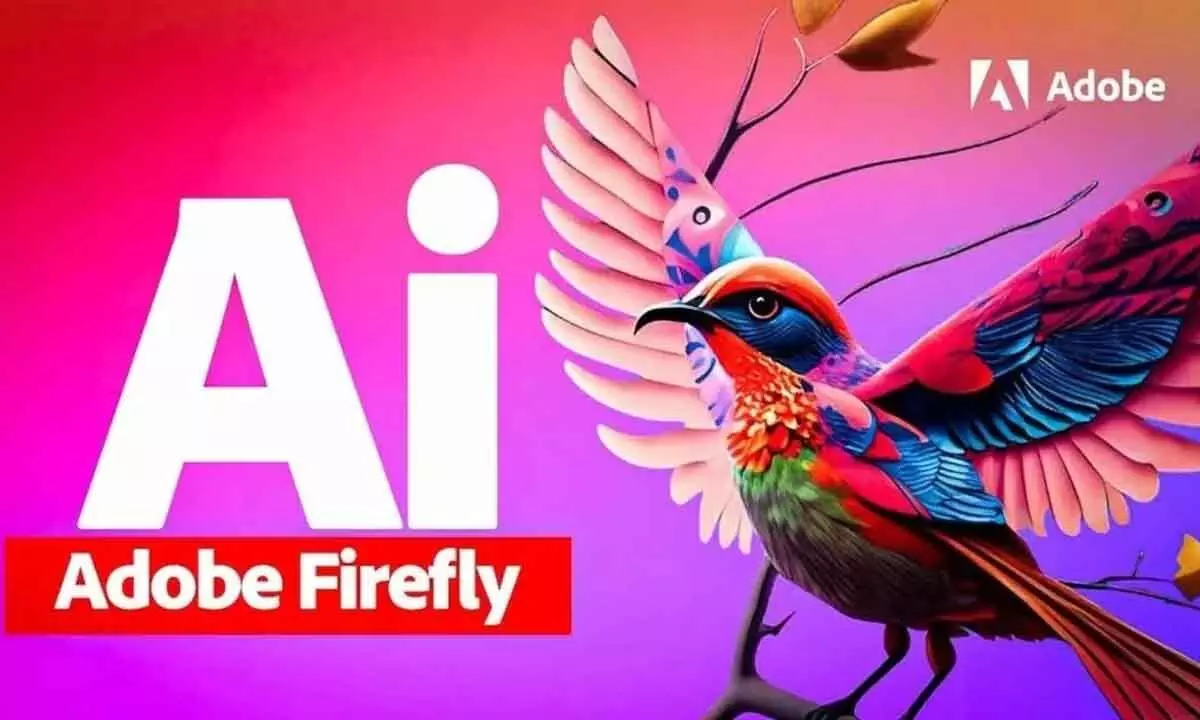Live
- They always want me to win, and now I feel lucky to have been offered a story like ‘Zebra’: Satyadev Kancharana
- ‘Democracy first, humanity first’: PM Modi in Guyana's parliament on two countries' similarities
- PKL Season 11: Telugu Titans register third straight win to top standings
- Is Pollution Contributing to Your COPD?
- NASA Unveils Underwater Robots for Exploring Jupiter's Moons
- Additional Central forces arrive in violence-hit Manipur
- AR Rahman and Saira Banu’s Divorce: Legal Insights into Common Issues in Bollywood Marriages
- 82.7 pc work completed in HPCL Rajasthan Refinery area: official
- Curfew relaxation extended in 5 Manipur districts on Friday
- Tab scam prompts Bengal govt to adopt caution over fund disbursement
Just In
Adobe Unveils New Firefly AI Video Tools: Features, Pricing, and More


Adobe launches new AI video tools like Text-to-Video, Image-to-Video, and Generative Extend, offering innovative, commercial-safe video creation solutions.
Adobe has made a significant leap in the artificial intelligence (AI) space by introducing its Firefly Video Model, aiming to challenge existing players like OpenAI and Meta. This cutting-edge AI video generator marks Adobe’s entry into the rapidly evolving field of AI-driven video creation. Currently, in a limited public beta phase, the Firefly Video Model offers creators an innovative way to enhance their video workflows while ensuring commercial safety, a key factor that Adobe emphasizes for users.
Key Features of Adobe’s Firefly Video AI Model
The Firefly Video Model introduces three exciting new tools to revolutionize video creation: Text-to-Video, Image-to-Video, and Generative Extend. These tools, designed to work seamlessly within Adobe’s suite, bring powerful video generation and editing capabilities that are both versatile and user-friendly.
The Generative Extend tool, now in beta within Adobe Premiere Pro, allows users to extend video clips by up to two seconds at resolutions of either 720p or 1080p at 24 frames per second (FPS). This is particularly useful for making small adjustments to footage without needing to reshoot, such as correcting unexpected movements or fine-tuning camera angles. Beyond visual adjustments, this tool also enables audio extensions, allowing sound effects or background noise to be lengthened by up to ten seconds. However, it does not currently support extending spoken dialogue or music, making it best suited for minor tweaks during the editing process.
On the web, two additional tools are now available in limited beta within the Firefly app: Text-to-Video and Image-to-Video. The Text-to-Video tool operates similarly to other popular generators like Runway and OpenAI’s Sora. Users simply input a text description to generate video content. The feature supports various styles, including traditional film, 3D animation, and even stop-motion, offering flexibility for different creative projects. Additionally, users can control “camera” settings to adjust angles, motion, and distances within the video, providing a dynamic experience for creators who want to fine-tune their content.
Image-to-Video
Another breakthrough tool, allows users to upload a reference image alongside a text prompt. This combination offers more creative control over the final output, enabling users to craft video content that aligns closely with their vision. This tool is especially helpful for tasks like generating b-roll footage from photos or simulating potential reshoots by working with stills from existing videos. Although it shows immense promise, Adobe cautions that this tool, like the others, is still evolving and has certain limitations during its beta phase.
One of the primary advantages of all these tools is their speed. While generating videos with these tools currently takes about 90 seconds, Adobe is actively working on a “turbo mode” to accelerate the process, making it even more efficient for users. This focus on speed and ease of use highlights Adobe’s commitment to delivering a seamless experience for video creators.
Commercial Safety and Compliance: Adobe’s Competitive Edge
A key feature of Adobe’s new AI tools is their emphasis on being “commercially safe.” Unlike competitors like Runway, whose models have faced scrutiny for being trained on copyrighted content from platforms like YouTube, Adobe has built its models on content that it owns the rights to use. This compliance with copyright regulations offers peace of mind to creators concerned about potential legal issues, making Adobe’s Firefly tools an attractive option for professionals looking to ensure their work is free from any legal encumbrances.
The importance of commercial viability cannot be overstated in the current digital landscape, where creators are increasingly mindful of copyright issues. Adobe’s proactive approach in building a copyright-compliant model may give it an edge over competitors like Meta, which have faced criticism for allegedly using personal videos without consent.
Pricing and Availability
Currently, the Firefly Video Model is available in limited public beta, and interested users need to join a waitlist to access the new tools. During this beta phase, Adobe is offering the video generation features for free. However, the company has not yet announced the pricing details for when the Firefly Video Model exits the beta stage. More information on pricing and availability is expected to be shared in the near future, as Adobe continues to refine its offerings.
Adobe’s Firefly AI Video Model is a promising new entrant in the AI video creation space, offering innovative tools like Text-to-Video, Image-to-Video, and Generative Extend. These tools not only enhance video workflows but also provide the reassurance of commercial safety, a critical factor in today’s content creation industry. As Adobe continues to develop these tools and expands its capabilities, creators can look forward to faster, more efficient video production solutions that align with the evolving demands of the market.

© 2024 Hyderabad Media House Limited/The Hans India. All rights reserved. Powered by hocalwire.com






